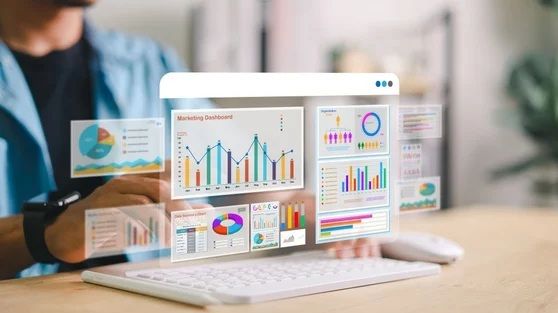Designing Websites for the AI-Powered Future: Beyond Visual Appeal

Summary: Discover how AI is revolutionizing web design. Learn about personalized, adaptive, and intelligent websites created by WSI, blending cutting-edge technology with user-centered design.
AI is redefining what a website can do. Traditional web design focused on static, user-centered models, but AI introduces new dynamics, enabling websites to adapt in real time and offer increasingly personalized experiences. And at WSI, we don’t just keep up—we build the future. From more innovative interfaces to adaptive design, we help businesses turn their websites into real-time, ROI-driving platforms.
AI and the Shift in User Expectations
AI is fundamentally changing how websites are built, designed, and experienced. What once required weeks of manual coding, testing, and fine-tuning can now happen in hours—or even minutes—thanks to AI-powered tools that automate workflows, enhance design logic, and intuitively address user needs. But AI is doing more than speeding up development; it’s redefining what users expect.
As consumers interact more with intelligent tech—from predictive text to chatbots and voice assistants—their standards evolve. Today’s users don’t just want fast load times and sleek design. They expect sites to anticipate their needs, understand their preferences, and respond quickly. This marks a shift from one-way interactions to digital experiences that feel more like conversations.
In web development, this shift is most visible in the rise of adaptive design. Static web pages give way to AI-driven interfaces that respond to each visitor’s behavior, location, and device. For example, a returning visitor may see personalized content based on past activity, while a mobile user is served a simplified site version for speed and convenience. These experiences rely on AI’s ability to analyze data in real time and optimize what’s displayed, how it’s displayed, and when.
Users also expect real-time responsiveness in how they search and interact with content. With voice-enabled devices on the rise, conversational search is becoming the norm, especially among younger users. AI is essential here, interpreting natural language, predicting intent, and returning intuitive results. That means websites need to optimize not only for typed keywords but also for spoken queries. Voice recognition and natural language processing are key to bridging that gap.
Behind the scenes, AI is revolutionizing how developers and designers work. Tools like GitHub Copilot offer real-time coding suggestions, while platforms like Figma use AI-powered plugins to generate design variations and automate tasks. This isn’t about replacing human talent—it’s about amplifying it. By taking over the repetitive work, AI allows creatives to focus on strategy, experience, and innovation.
The right tools make all the difference. Frameworks like TensorFlow enable developers to build custom models that predict user behavior. Adobe Sensei brings AI to visual and functional design. Platforms like HubSpot now offer AI capabilities that enhance campaign performance and customer experience. The key is to align your tech stack with your goals—whether that’s personalizing content, automating support, or improving conversions.
Of course, incorporating AI into web development brings challenges. Chief among them: data privacy. AI thrives on user data, but it must be handled responsibly. Compliance with regulations like GDPR and CCPA is essential, and transparency is key to building trust. Encryption, anonymization, and ethical data practices must be built into every AI strategy.
Another challenge is the learning curve. Many teams are still catching up with AI’s fast pace. Adopting can feel daunting for those unfamiliar with machine learning or natural language tools. The solution? Start small. Leverage user-friendly platforms, seek expert support, and gradually train your team to build confidence.
There’s also a risk of over-automating and losing the human touch. While AI can generate layouts, write content, and predict design needs, the heart of a great website still comes from human creativity, empathy, and storytelling. The best results come from a balanced approach—AI handling the heavy lifting and people shaping the emotional and strategic narrative.
Looking ahead, the future of AI in web design will bring even more intelligent, immersive experiences. Hyper-personalization will go beyond segments to meet the specific needs of each individual visitor. Imagine a site that adjusts based on your weather, purchase history, or even inferred mood. AI makes that possible in ways that feel seamless, not invasive.
We’ll also see the rise of autonomous websites. AI models will monitor performance, run continuous A/B tests, and implement updates without manual input. While this won’t eliminate the need for creative direction, it will reduce time spent maintaining and optimizing websites, freeing teams to focus on innovation.
So, what does all of this mean for today’s digital marketers and businesses? The AI shift isn’t coming—it’s already here. Staying competitive means adapting now. That doesn’t require a total rebuild but calls for strategic changes. Start by using schema markup and structured data to make content AI-readable. Test out chatbots or voice search tools. These small steps yield significant insights.
Website Design Beyond Aesthetics: Prioritizing Clarity and Usability
Yes, a beautiful website helps. But the aesthetics won’t save you if visitors can’t figure out where to click or how to get what they need. Great design isn’t about showing off—it’s about making sure people can actually use your site without wanting to throw their laptop.
Start with the basics: Who’s visiting your site, and what do they need? If your design doesn’t help them do that—buy something, find information, or book something—it’s not working.
Once you know what your users need, make it functional. That means pages that load quickly, content that’s organized in a way that makes sense, and buttons that actually look like buttons. If people have to think too hard about where to go next, they won’t go anywhere. They’ll leave.
Good design guides attention without screaming for it. Font size, contrast, spacing—they’re not just style choices. They’re how you say “this matters” without actually saying it. When done right, users get what they need at a glance. When done wrong, they get overwhelmed and bounce.
Navigation is another dealbreaker. If your menu feels like a puzzle, you’ve already lost. People don’t want to guess what’s behind “More”. They want clear paths, obvious labels, and a site that behaves like other good sites. Not because they lack imagination, but because they’re busy.
And let’s talk about whitespace. Not as in “throw a bunch of empty space on the screen and call it minimalism.” Real whitespace makes content easier to read. It separates stuff that doesn’t belong together. It gives users room to breathe. People won’t stick around long enough to read anything if your site feels cluttered.
Want to know if your site works? Watch someone use it. Not in a “sit behind them breathing loudly” kind of way—just observe. Usability testing shows you what analytics can’t. Where people hesitate, what they miss, and what annoys them. You’ll find the issues fast. Then you can fix them.
Design is never one-and-done—iteration matters. You test, tweak, test again. That’s how you build something that actually serves people. And guess what? The best sites evolve. So should yours.
Aesthetics still matter—but not at the expense of clarity. Don’t let “pretty” get in the way of “useful”. A sleek, stylish site that confuses people is just a digital billboard for bounce rates. And sure, the aesthetic-usability effect is real. People are a little more patient when things look nice. But that patience runs out fast if the experience is clunky.
There’s also room for emotional design. Your site should feel like you. Typography, color, and imagery can create a vibe, build trust, and invite people back. Just don’t let the vibe take over the experience.
Some quick real-world reality checks: one site had a cool-looking dropdown menu. The problem was that no one knew how to use it. Simplifying it led to happier users. Another had a clean, minimalist checkout page. It was too clean, actually—people didn’t know where to click. Adding a few cues made conversions jump and cart abandonment drop.
And when you stray too far from the norm, expect resistance. A real estate platform attempted to reinvent standard layouts but failed. After redesigning with familiar patterns, user engagement significantly increased.
Bottom line: clarity and usability aren’t optional. They’re the whole point. Great websites help people do what they came to do—quickly, easily, and without confusion. That’s what keeps them coming back.
WSI: Designing Websites for the AI-Powered Future
AI-powered websites don’t sit still. They react, learn, and shift based on what people actually do on the page. Click a product? The next suggestion is smarter. Pause for too long? Maybe the site nudges you. These aren’t static pages—they’re responsive systems built to meet users halfway, sometimes before the user even knows what they need.
The trick is making all this intelligence feel invisible. Nobody wants a site that feels like it’s watching them. They want a site that just… works. Seamlessly. Like it gets them. That’s the challenge—build AI without making it weird.
At WSI, that’s what we’re aiming for. We build websites that look good, yes, but more importantly, ones that adapt. Think product recommendations that don’t feel random, search results that actually make sense, and forms that don’t ask for things they already know—smart design backed by smart tech.
What makes AI-driven sites better? A few things. First, they’re personal. Not in the creepy way—just in the “this makes sense for me” way. The content adjusts. The layout responds. The whole thing feels more tailored, less generic.
They’re also proactive. Traditional sites wait for users to do something. AI-powered sites gently guide, suggest, and even assist without being pushy. Need help? It’s already there. Thinking of checking out? Here’s a reminder of what you left behind.
And it’s not just about the tech. Good AI is invisible when the UX is proper. That’s where actual designers come in—because even the most innovative system is useless if it’s confusing or clunky. The goal is to make the AI-powered stuff feel like second nature.
That means collaboration. Designers and developers are working together, not just to shove AI in for its sake but to ask: Is this helping the user? Is this solving a real problem, or just showing off?
AI design also has rules—the real kind, not just style guidelines, ethical ones. These include respecting privacy, being transparent about how data is used, and avoiding dark patterns. People should know what the site is doing—and why.
It also means constant iteration. AI doesn’t stand still, and neither should your website. Every click, every scroll, every bounce is feedback. And the best sites take that seriously. Test. Improve. Repeat. That’s how you stay ahead.
The way we design has to change, too. You can’t just bolt AI on at the end. It has to be part of the thinking from the start. Where can AI make the experience easier? Where does it actually help? That mindset shapes the whole build.
Design can’t be limited to a single screen anymore. Users are bouncing between devices, channels, and even realities. So AI has to follow seamlessly. From homepage to help center, from phone to tablet to desktop, the experience needs to hold together.
Bottom line: the future of web design isn’t just smarter. It’s more human. Because the goal isn’t to make websites that impress machines; it’s to build ones that actually work for people.
Leveraging AI to Build the Future of Web Design
AI is already a big part of web design. And no, it’s not coming to take designers’ jobs. It’s coming to take their busywork.
At WSI, we’re using AI to automate the stuff that slows people down—layout tweaks, endless A/B tests, and fine-tuning content. The things that eat up hours and drain creative energy. When AI handles the grunt work, designers get to focus on what actually matters: making digital experiences that feel smart, personal, and worth someone’s time.
We don’t use AI as a gimmick; we use it as a powerful tool. It helps us move faster, test smarter, and build sites that grow alongside their users.
This isn’t about building flashy, futuristic pages that look like they belong in a sci-fi film. It’s about creating websites that work and even win web design awards. Personalized. Adaptive. Helpful, without being overbearing.
The best part? These sites don’t just launch and sit there. They evolve. AI watches what works and what doesn’t, then helps us refine it. Behind every click, there’s an opportunity to learn something and make it better.
So if your site still feels like a static brochure—or worse, a digital maze—it might be time to rethink the whole thing. More innovative design isn’t about adding more. It’s about designing with purpose, with tools that actually understand how people interact online now, not ten years ago.
Let’s make something intelligent together. For more information, please contact us.
About the Author
Rick spent 20 years in the insurance industry in finance, primarily developing reporting platforms for B & C stakeholders. His ability to speak to consumers of data (managers and analysts) and translate their needs to programmers led him to start his own digital marketing agency in 2004 to develop data driven solutions for business owners.
The Best Digital Marketing Insight and Advice
We are committed to protecting your privacy. For more info, please review our Privacy and Cookie Policies. You may unsubscribe at any time.
Don’t stop the learning now!


